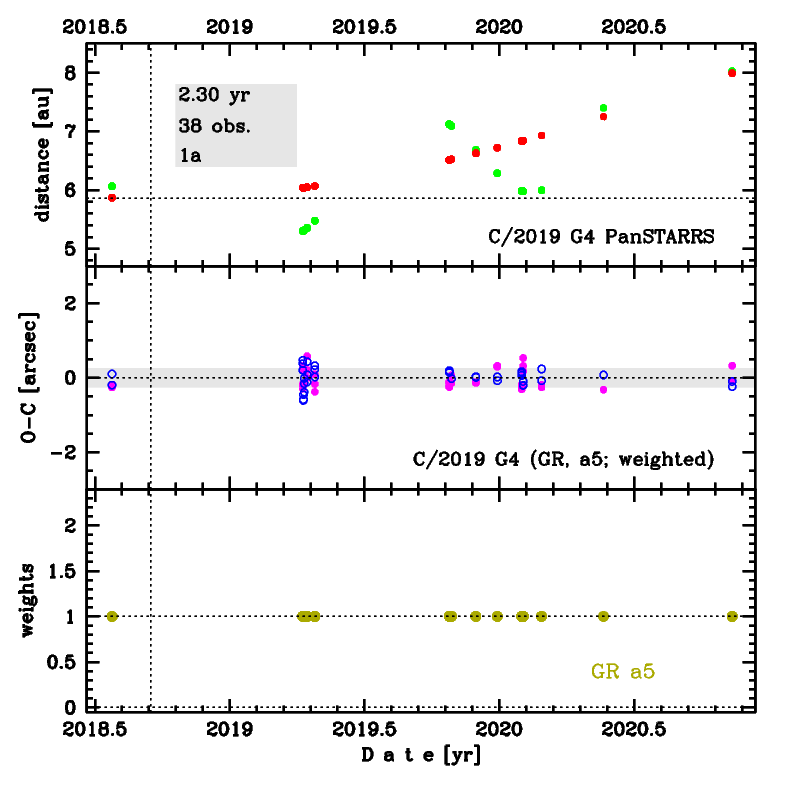C/2019 G4 PanSTARRS
more info
Comet C/2019 G4 was discovered on 9 April 2019, about 7 months after its perihelion passage. Later a two pre-discovery observations were found from 24 July 2018, these two measurements are the only data taken before perihelion passage.
Solution given here span over 2.30 yr in a range of heliocentric distances: 5.87 au – 5.86 au (perihelion) – 7.99 au.
This Oort spike comet suffers small planetary perturbations during its passage through the planetary system that lead to a more tight future orbit (see future barycentric orbit).
Solution given here span over 2.30 yr in a range of heliocentric distances: 5.87 au – 5.86 au (perihelion) – 7.99 au.
This Oort spike comet suffers small planetary perturbations during its passage through the planetary system that lead to a more tight future orbit (see future barycentric orbit).
| solution description | ||
|---|---|---|
| number of observations | 38 | |
| data interval | 2018 07 24 – 2020 11 11 | |
| data type | perihelion within the observation arc (FULL) | |
| data arc selection | entire data set (STD) | |
| range of heliocentric distances | 5.87 au – 5.86 au (perihelion) – 7.99 au | |
| detectability of NG effects in the comet's motion | NG effects not determinable | |
| type of model of motion | GR - gravitational orbit | |
| data weighting | YES | |
| number of residuals | 75 | |
| RMS [arcseconds] | 0.26 | |
| orbit quality class | 1a | |
| orbital elements (barycentric ecliptic J2000) | ||
|---|---|---|
| Epoch | 2327 05 23 | |
| perihelion date | 2018 09 13.65215360 | ± 0.00317841 |
| perihelion distance [au] | 5.85682233 | ± 0.00002067 |
| eccentricity | 0.99895785 | ± 0.00001191 |
| argument of perihelion [°] | 287.749357 | ± 0.000371 |
| ascending node [°] | 130.490630 | ± 0.000051 |
| inclination [°] | 138.341386 | ± 0.000045 |
| reciprocal semi-major axis [10-6 au-1] | 177.94 | ± 2.03 |
| file containing 5001 VCs swarm |
|---|
| 2019g4a5.bpl |

Upper panel: Time distribution of positional observations with corresponding heliocentric (red curve) and geocentric (green curve) distance at which they were taken. The horizontal dotted line shows the perihelion distance for a given comet whereas vertical dotted line — the moment of perihelion passage.
Middle panel(s): O-C diagram for a given solution (sometimes in comparison to another solution available in CODE), where residuals in right ascension are shown using magenta dots and in declination by blue open circles.
Lowest panel: Relative weights for a given data set(s).
Middle panel(s): O-C diagram for a given solution (sometimes in comparison to another solution available in CODE), where residuals in right ascension are shown using magenta dots and in declination by blue open circles.
Lowest panel: Relative weights for a given data set(s).
